Reinvesting Energy Dollars In The Classroom
 Despite some reprieve granted by the country’s abundant natural gas sources, energy costs in the United States continue to creep up. In some markets, electric rates have increased by as much as 40 percent overnight.
Despite some reprieve granted by the country’s abundant natural gas sources, energy costs in the United States continue to creep up. In some markets, electric rates have increased by as much as 40 percent overnight.
Coal-fired electric generation is now facing much more stringent emission regulations. This not only increases the cost to generate power, but adds support for higher natural gas prices as demand increases due to conversion from coal to gas. As one fuel helps set the cost for others, all energy sources are impacted, whether for power generation, transportation or space heating.
As homeowners become more energy savvy, school districts across the country — many of which are equipped with outdated, oversized systems — are making changes to their own infrastructure in order to adapt.
Crossroads Middle School, in South Brunswick Township, N.J., is a modern school by most standards. The only exception — although not obvious to visitors or students — was a big one. Until this winter, the 133,000 square-foot building was heated with two, 16-million BTU fire-tube boilers, each the size of a school bus. Despite being natural gas-fired, heating costs averaged $63,000 each year. As a result, the district has focused on mechanical system efficiency.
That initiative gained real thrust about four years ago when the district teamed with engineers and designers at consulting firm EffectivEnergy Solutions. The company’s five professionals work out of offices in West Chester, Pa. and Princeton, N.J. Their specialty: energy efficiency consulting and mechanical system design.
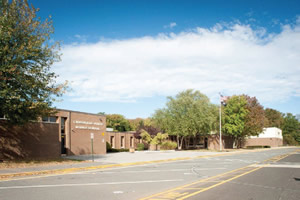
PHOTOS COURTESY OF BRADFORD WHITE
DEVELOPING A PLAN
“We were initially referred to the district for an energy audit,” said President Bob McGreevy, PE CEM. “Since that beginning, we’ve assisted Anthony Tonzini, South Brunswick Board of Education’s business manager and board treasurer, to meet his vision of cost-effective energy conservation progress, improving comfort and reducing maintenance cost in the district’s 12 schools. Part of that process has been for the district to hire a full-time energy specialist, whose job it is to provide continuous improvement in energy reduction throughout the district. We’ve found the perfect fit with Paul Bennett.”
“We’ve looked closely at how we can cut energy expenses and reinvest it into education,” said Bennett. “A dollar saved in the boiler room is one that we can spend in the classroom. Ultimately, our goal is to provide an optimal learning environment.”
So far, mechanical system changes have been made at three of the district’s schools and other low-cost energy conservation measures in the other schools. As a result, the district’s average annual energy spend has fallen from $3.00 per square-foot to $1.82. As time passes and energy costs rise, the savings improve further.
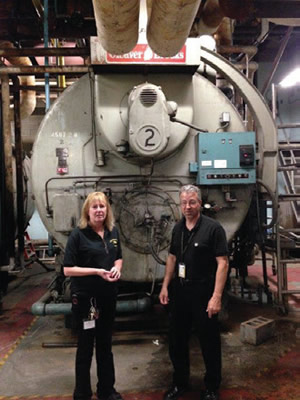
Burning money. Crossroads Middle School is one of 12 buildings in South Brunswick (N.J.) School District, all of which have or will go through major energy improvements. This is one of the original 16 MMBTU fire-tube boilers that was replaced before this past winter as part of a plan that is expected to save the district hundreds of thousands of dollars in energy costs each year.
While the 60-year-old boilers at Crossroads were a glaring blemish on the building’s energy profile, McGreevy first aimed to diminish the school’s existing heat load before tackling the mechanical room. During their initial energy audit, Effectiv discovered that the building required 1.7 million BTU at design conditions.
“From the very beginning, we had planned to tear out the boilers and replace them with new Bradford White Brute condensing units over the 2014 summer, but there was a lot that could be done within the building to multiply the benefits,” explained McGreevy. “As an industry, we need to start looking at how to intelligently handle ventilation air in public buildings. That’s how we started at Crossroads.”
During the audit, careful attention was paid to the existing air handling equipment. According to McGreevy, most systems are sized to supply enough fresh air to accommodate maximum occupancy in every room simultaneously, regardless of what the actual occupancy level is.
SMARTER VENTILATION, SMALLER BOILERS
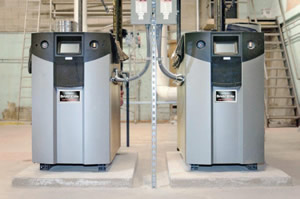
Size may matter. EffectivEnergy Solutions teamed with Centralpack Engineering to shrink Crossroads Middle School’s installed heating capacity by nearly 90 percent. In addition to replacing the original boilers, which were about the size of school buses, with new, very much more efficient boilers, changing to more efficient ventilation systems and implementing some innovative heat recovery practices, the district will be cutting energy expenses and reinvesting those saved funds into education.
“Rarely, if ever, do you see a completely ‘full’ building,” he explained. “So you’re conditioning far more outdoor air than you need to. And that’s an expensive practice, especially in the dead of winter. Per AHSRAE 62, we’re able to reclassify that air if we clean it, and if we monitor Co2 levels at a room-by-room basis. It’s a much more intelligent means of providing acceptable IAQ.”
Effectiv designed a new demand control ventilation system to supply the actual air changes required. Mechanical contractor, Centralpack Engineering Corp, installed the components, which included VAV makeup air units equipped with electrified carbon filament air cleaners made by Dynamic Air Quality Solutions, Co2 sensors to detect occupant density levels, and an energy management system that controls the overall sequence of operation.
By cleaning classroom air and mixing it with outdoor air according to its Co2 content, Effective was able to lower the required fresh air CFM from 15 to six. For the building as a whole, they’ve been able to reduce the makeup air volume by more than 50 percent.
BOILER REDUCTION
“Addressing the ventilation air allowed us to get even more aggressive with the capacity reduction of the new boilers,” said McGreevy. “We now have a total installed capacity of 3.4 MMBTU as opposed to 32 MMBTU.”
Taking up a fraction of the old boilers’ footprint are now two, 1.7-million BTU Bradford White Brute condensing boilers. Given their five-to-one turndown ratio, the school now effectively has 10 stages of heat input. The 95-percent efficient, low-NOx boilers supply 120°F to a variety of terminal units, a substantial reduction from the 180°F that the original boilers supplied.
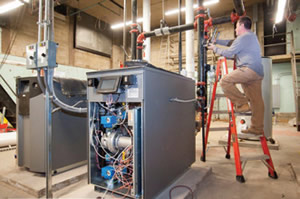 “We were able to drop the supply water temperature because there’s less heat needed in the rooms now, but none of the connected radiation was removed,” explained McGreevy. “Being able to lower the supply temp and shoot for a broader delta-T is a benefit you get with a stainless steel heat exchanger, like in the Brute.”
“We were able to drop the supply water temperature because there’s less heat needed in the rooms now, but none of the connected radiation was removed,” explained McGreevy. “Being able to lower the supply temp and shoot for a broader delta-T is a benefit you get with a stainless steel heat exchanger, like in the Brute.”
Throughout the school, a hodgepodge of radiation — or what McGreevy likes to call “mechanical sprawl” is used to heat the building. Cassettes, ceiling panel radiation, fan coil units, cabinet unit heaters and hot water coils are utilized extensively.
Centralpack Engineering Corp. was hired for the boiler replacement as well as the air-side retrofit. The company’s industrial and commercial HVAC focus lent itself perfectly to the application. The 12-person firm has served New Jersey, New York and Pennsylvania since 1974.
“The old boilers were gone before we arrived,” said Centralpack Engineering Foreman, Bill Helmstetter. “It took two of us 10 days to re-pipe the new system. The hardest part was getting the six-inch supply and returns in the air. Effectiv helped with controls during commissioning.”
“The ability to easily interface with a BACnet system was a plus with the Bradford White boilers, but we also spec’d them because it’s a quality, American-made product with a good warranty and great tech support,” said McGreevy.
“Space to work in the mechanical room wasn’t lacking on this project,” said Bill Helmstetter, Centralpack Engineering foreman. “We could literarily have parked two service trucks in the mechanical room with the space left over after removal of the old boilers. Working inside the boiler was a breeze too. All electrical connections are mounted on a drawer that pulls out of the cabinet for easy access.”
If two tiny boilers lost inside a cavernous mechanical room aren’t indicative of what EffectivEnergy Solutions was able to accomplish with a smarter system design, the gas line feeding the boilers speaks volumes. The original six-inch gas line was cut and tapered down to two-inches before reaching the new boilers.
But, the intelligent design for the school has another interesting facet.
HEAT AS A BYPRODUCT
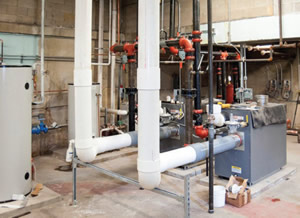 As most schools do, Crossroads has one large walk-in-box cooler, as well as a walk-in freezer. The air-cooled equipment continuously sheds heat. McGreevy designed a heat recovery system to harvest the heat from the coolers and apply it toward DHW production.
As most schools do, Crossroads has one large walk-in-box cooler, as well as a walk-in freezer. The air-cooled equipment continuously sheds heat. McGreevy designed a heat recovery system to harvest the heat from the coolers and apply it toward DHW production.
A wall-hung, HotSpot Energy refrigerant-to-water heat exchanger takes waste heat from the two-HP cooler and three-HP freezer, and preheats supply water for the school’s water heater. Via the exchanger, the 160°F refrigerant heats water that’s circulated through a 120-gallon buffer tank. This tank then supplies pre-heated makeup water to the 80-gallon DHW storage tank and dedicated gas-fired volume water heater.
“Based on other installations we’ve done like this one, we know that the waste heat recovery system is reducing the school’s DHW load by about 75 percent,” said McGreevy. “Not to mention, the walk-in-boxes aren’t working as hard to shed heat, either.”
“Working with Effectiv has been fantastic,” said Bennett. “They step out of the office and spend countless hours onsite, allowing them to present simple yet effective solutions to real-world challenges. The relationship has really propelled us toward our goal of providing the best educational experience possible by eliminating wasteful energy problems.
By reducing the school’s heat load and installing more efficient boilers, the school is expecting a 30,000 therm (60 percent) reduction over the course of the 2014/2015 heating season. Effictiv is already designing system changes at all the other schools in the district, which range from 17 to 90 years old. Going forward, the district’s overall goal is to continue to reduce heating costs by efficiently shrinking heat load requirements in buildings. By doing so, the school can replace oversized and inefficient equipment with high-efficiency systems and proper control.
“When a school does nothing to improve in efficiency, costs creep by about 5 percent per year,” said McGreevy. “The district’s goal is to reduce costs by about 5 percent each year through upgrades like this.”
This article originally appeared in the issue of .